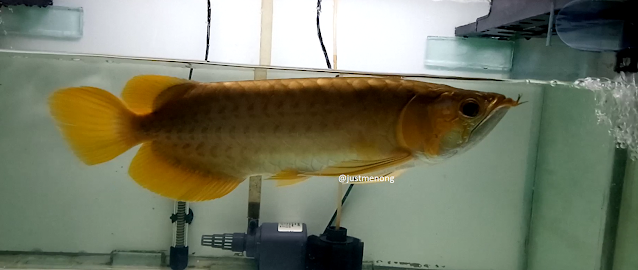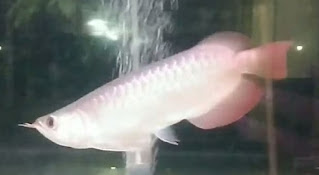One of the businesses that Zauji has been running for a long time is buying and selling fish. Zauji does not cultivate fish on his own but buys them in a grocery store or from a retail merchant for resale. Because I often accompany Zauji, I know a little bit, so I know how to care for arowana fish.
Arowana, or Arowana, is an ancient fish that is included in the family Osteoglossidae. Widely spread across Africa, Southeast Asia, Australia, and South America, the arowana has long been a symbol of luck and prosperity. Fans of dragon fish are not only dominated by middle-aged but also young people.
Arowana fish have unique scales and mouth shapes with the bottom of their mouths that look sharp upwards. The size of the Arowana fish can reach 3 meters (a certain type), although the most common is found around 50 cm.
There are many species of Arwana fish, but only a few are often cultivated and maintained, such as Arowana Super Red, Arowana Golden Red, Arowana Silver, Arowana Banjar, and Arowana Jardini.
Arowana Super Red ranks first, which has the highest selling value. The most expensive Super Red Arowana that I and Zauji have seen are in the price range of Rp. 30 - 40 million. And certainly not just anyone who can take good care of it.
In addition to knowledge about Arowana fish and experience around enlargement (fish size > 10 cm), quality improvement (how to maximize color in fish) and consumer selection, because of course not arbitrarily people who dare to buy fish for tens of millions of rupiah.
A good arowana fish anatomy is a spoon-shaped head, flat eyes, proportional body length and width, aggressive swimming, long (dungi leaves), and wide-tailed openings.
Aquarium
Because the body is flat and elongated, Menong's friends certainly need an aquarium with the appropriate shape. The first option is certainly tailored to the length of the fish. Unlike other fish such as the louhan, which is measured using a finger (one finger, two fingers, or five fingers), Arowana fish are measured using measuring instruments such as rulers and meters, measuring from the outermost part of the caudal fin to the tail end.
After knowing the size of the fish, then we can determine the size of the tank needed by using the formula 2 times the size of the fish, so if we have a fish with a size of 30 cm, then the minimum length of the aquarium is 60 cm with a width of 30 cm. As for the height, it can be adjusted to the size of the width of the body. This size is a minimal size, but it would be better if the size were bigger so that the fish could be more free to move so that it is healthier.
Menong friends can also give a spotlight on the side of the aquarium on the back and bottom. because there is a theory that says that environmental conditions, one of which is color, can affect the color of the fish. In addition, a plain spotlight at the bottom of the aquarium is also believed by some people to prevent the eyes of Arowana dropeye (DE) because there is no shadow of the fish so that the fish's eyes do not only focus on looking down.
Arowana fish include hunting or predatory fish; even this fish is not reluctant to jump if there is food on it. Therefore, if we maintain the anawana, we must close the aquarium by using materials that are not too heavy so as not to overload the aquarium but also not strong enough to be encouraged by the Arwana when jumping.
The most frequent water-resistant material Zauji is a fiber that is given a glass ballast so that it does not easily shift. Another material is plywood, but make sure it is not easily damaged by water!
The most important thing is that the top is closed. Zauji himself and some novice buyers had a bad experience with the incident of the Arowana jumping and being found in a state of disarray the next day. Even though the price of fish is quite low 😓.
Aquarium water does not need to be filled up but only 2/3 parts to keep when the fish jumps so it does not hit the cover and get hurt. It is said that water that is not too full also keeps the eyes of the Arowana fish from experiencing DE or drop eye.
Drop eye is a condition of the eyes of the Arowana fish that go down and cloudy. In addition to bacterial and water infections. Drop is one of the characteristics of arowana fish that is less qualified.
The aquarium is also good to be placed in a place that we usually pass so that fish get used to the crowd. An aquarium containing fish located in a corner or a place that is rarely passed by people will make the fish not accustomed to the crowd and will be surprised when there are people who pass by so that it is easy to stress, feel pain, and eventually die.
Water Conditions
Water conditions actually affect the growth of Arowana fish. Water temperature can be a friend of the cut to set using a heater-thermometerat 26 – 30°C. With a temperature that is fairly warm, especially in the rainy water, Arowana fish will be more comfortable and avoid the growth of mold. It’s just that the use of the heater will increase the use of electricity quite a lot.
In addition to temperature, keep the pH of the water in the range of pH 5 – 8. Do not forget the circulation and filtration of the water so that dirt does not accumulate in the aquarium.
When first buying or moving the Arowana fish (or any kind) from the old aquarium to the new aquarium, use the tricks that Zauji used to do. Buy to ask the seller not to feed the Arowana fish (or other types) that we will choose at least 1 x 24 hours before. Zauji had suffered a loss because the fish died when he just arrived home because it turned out that the fish had only been fed a few hours earlier. The fish died with the feed still in his mouth.
When arriving at the house, put the Arwana fish, which is still in a plastic bubble container, in the aquarium to be used. Do not forget to fill the aquarium with groundwater or PDAM water that has been left at least one night.
Let the fish recognize its new environment before Menong’s friend opens a plastic container and inserts the Arowana fish into the aquarium.
Similarly, when changing the aquarium water. Do not replace the entire aquarium water with new water. Use a maximum of 30% of new water (groundwater or PDAM water that has been left overnight, yes) to be mixed with old aquarium water.
Add fish salt as a complement so that the mushrooms are difficult to grow.
Feed
When raising Arowana fish, of course, we have to choose the best feed that can support how to care for Arowana fish to be large quickly. Protein becomes an important nutrient so that the growth of fish becomes maximized. Natural feed such as frozen silk worms (blood worms), crickets, Hong Kong caterpillars, or frogs can be fed to menong, chosen according to the size of the fish.
A small arowana is enough to be fed frozen worms or Hong Kong caterpillars that are soft and easy to digest. Crickets and German caterpillars can be given when the size of the fish starts to be large. In addition to containing beta carotene that can affect the color of the light red, especially for Arowana GR, crickets can also move agilely so that they are suitable. Do not forget to cut the legs first so as not to injure the fish.
The centipede can be given occasionally as an additional nutrient. Fresh shrimp can be given for the type of silver or GR.
All these types of feed can be purchased at the bird feed store except frozen worms, which are only in ornamental fish stores.
Give feed a day 2–3 times for Arowana fish that are still measuring <12 cm and reduce feeding as the body grows. Feed is given in sufficient quantities so that no remnants of feed remainscattered at the bottom of the aquarium that can cause the DE because the fish automatically look towards the remnants of the feed. The rest of the feed and lack of good circulation and filtration of water can make the quality of the water change because the pH changes.
Tankmate
A tankmate is a friend of the Arowana fish in the aquarium so that the Arowana fish is not lonely and easily stressed. Among friends, they can choose a tankmate smaller than the Arwana fish that friends are kept with, but not too small or it will be eaten.
Do not choose other predatory fish as a tankmate, like an alligator.
Zauji often chooses manfish, kaviat, P-Bass, or peacock bass and others as tankmates.
Tanning Light
Tanning lights are commonly used to bring up colors, especially for Super Red Arowana fish. Although the price is expensive, the demand for Arowana fish with a bright red color is always there because, in addition to being beautiful, there is a pride in having a Super Red Arowana.
Zauji itself only has one Arowana Super Red fish measuring 24 cm. Because the red color has not appeared and the structure of the back is deformed, aka 'nungging,' the price is only in the range of Rp. 2.4 million.
In addition to good feed, the color on the Super Red Arowana fish can be raised by tanning. Tanning is an irradiation by using ultraviolet (UV) lights at 315 - 400 nm (UV A) wavelengths and wavelengths of 280 - 325 nm (UV B).
UV lamps are placed in front of the aquarium (top and side) in a position directly facing the scales to be pigmented for 6-12 months. The tanning process is usually done on Arwana fish with a size of > 30 cm.
One of the shortcomings of tanning is that it can give rise to the eyes of the DE because spontaneously the fish eyes will look downwards to avoid exposure to light lamps.
The tanning process and also how to care for Arowana fish to be quickly large and of quality are usually done by sellers with a certain market share that do like Arowana fish regardless of the price. It is also not strange if the price is pegged very high because the treatment process takes time, energy, costs, and experience.
Not only enjoy the beauty; Menong friends must also pay attention to how to care for Arowana fish to be quickly large, healthy, and of quality.








Post a Comment
Post a Comment